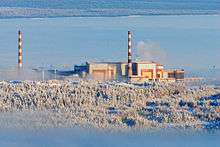Renewable energy in Russia
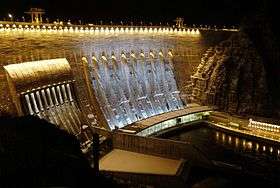
Renewable energy in Russia mainly consists of hydroelectric energy. The country is the sixth largest producer of renewable energy in the world, although it is 56th when hydroelectric energy is not taken into account.[1] Some 179 TWh of Russia's energy production comes from renewable energy sources, out of a total economically feasible potential of 1823 TWh.[2] 16% of Russia's electricity is generated from hydropower, and less than 1% is generated from all other renewable energy sources combined. Roughly 68% of Russia's electricity is generated from thermal power and 16% from nuclear power.[3]
While most of the large hydropower plants in Russia date from the Soviet era, the abundance of fossil fuels in the Soviet Union and the Russian Federation has resulted in little need for the development of other renewable energy sources. There are currently plans to develop all types of renewable energy, which is strongly encouraged by the Russian government.[4] Russian Prime Minister Dmitry Medvedev has called for renewable energy to have a larger share of Russia's energy output, and has taken steps to promote the development of renewable energy in Russia since 2008.[5]
History
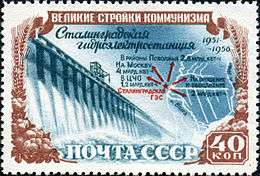
Most sources of renewable energy are new to Russia and have experienced development in recent years. However, hydroelectric power has a long history in Russia, dating back to the Soviet era. The rapid expansion of hydroelectric power in the Soviet Union began in 1930, when the total installed capacity equaled 600 MWh. The Soviet Union built its first windmill in 1941, which had a capacity of 100 kW.[6] By the time the Soviet Union collapsed in 1990, it had a total installed capacity of 65 GWh. The largest dams that Russia currently has, including the Sayano–Shushenskaya Dam, were built in the 1950s and 1960s.[7] From the 1970s to 2000, the Soviet Union and Russia focused mainly on "traditional" power sources: thermal-, hydro- and nuclear power.[6] However, in 1986, the Soviet government announced new energy goals, which included further hydroelectric plant construction as well as the start of small-scale solar and wind use for electricity production. Overall, Soviet energy policy focused on nuclear and thermal power, although renewable energy was not completely neglected. The dissolution of the Soviet Union prevented those goals from being fulfilled.[8]
The construction of the large dams prominent in Soviet times largely ended in the 1990s with the creation of the Russian Federation. In addition, due to the post-Soviet recession, much of the country's infrastructure, including dams, fell into disrepair.[7][9] Use of oil and gas for energy took priority in Russia and renewable energy was ignored. This policy lasted until 2008, when Medvedev announced reforms to Russia's energy policies in an attempt to focus more on renewable energy. Since then, there has been rapid development of new renewable energy sources.[10]
Current status
Russia is one of the world's largest producers of energy, most of which it obtains from oil, natural gas and coal. The country's focus on those resources for production and export, which constitute 80% of foreign trade earnings, means it has paid little attention to renewable energy. Out of the 203 GW of electric generation capacity that Russia has, 44 GW comes from hydroelectricity, 307 MW from geothermal, 15 MW from wind and negligible amounts from other renewable sources.[11][12] In 2009, the Russian energy industry generated a total 992 TWh of electricity, 176 TWh of which was produced by hydroelectric power stations.[13] Some of Russia's hydroelectric power plants are outdated and are in need of additional investment, as shown by the accident at the Sayano-Shushenskaya HPP in 2009.[1]
President Dmitry Medvedev announced in May 2010 that the Russian government would strongly consider purchasing electricity generated from renewable energy sources in an attempt to encourage development of renewable energy. The government has plans for 4.5% of Russia's energy output to come from non-hydroelectric renewable energy sources.[5] Additionally, in November 2010, the government approved a US$300 billion program to make factories and buildings more energy efficient; it also announced plans to construct eight energy-efficient lamp production plants, promote recycling and support the construction of a hybrid car plant. Medvedev announced in late 2009 that he wanted to cut Russian energy consumption by 40% by 2020.[10][14] At the moment, development is slowed by low investment, economic instability, low public demand and low tariffs on heat and electricity.[15] Subsidies for natural gas are another obstacle to renewable energy development.[16]
Hydropower
Hydropower is the most used form of renewable energy in Russia, and there is large potential in Russia for more use of hydropower. Russia has 102 hydropower plants with capacities of over 100 MW, making it fifth in the world for hydropower production. It is also second in the world for hydro potential, yet only 20% of this potential is developed.[7] Russia is home to 9% of the world's hydro resources,[15] mostly in Siberia and the country's far east. At the end of 2005, the generating capacity from hydroelectric sources in Russia was 45,700 MW, and an additional 5,648 MW was under construction. The World Energy Council believes that Russia has much potential for using its hydro resources, with a theoretical potential of about 2,295 TWh/yr, with 852 TWh being economically feasible.[12]
The largest dams in Russia are the Sayano-Shushenskaya Dam, which has an installed capacity of 6,400 MW; the Krasnoyarsk Dam (6,000 MW); the Bratsk Dam (4,500 MW); the Ust-Ilimsk Dam (4,320 MW) and the Zeya Dam (1,330 MW).[7] Some of the most recent dam projects are the Bureya Dam (2010 MW) and the Irganai Dam (800 MW). The Boguchany Dam (1920 MW), Zelenchuk Dam (320 MW), Zaramag Dam (352 MW) and Nizhne-Chereksky (60 MW) are currently under construction.[12] RusHydro is the largest hydroelectric company in Russia and the second largest hydroelectric producer in the world.[17] In October 2010, China Yangtze Power, the largest hydropower corporation in China, and EuroSibEnergo, a Russian energy company, signed a cooperation agreement to expand hydroelectric energy production in Russia and export energy to China's northern territories.[18] The West Siberian Generating Company has plans to start construction of eight mini-hydroelectric power plants in the Altai region before 2015.[19]
On 17 August 2009, there was an explosion at the Sayano-Shushenskaya hydroelectric power plant, which killed 75 plant workers and injured 13. The Federal Service for Ecological, Technological, and Nuclear Supervision's investigation concluded that poor management and technical flaws were responsible.[20] The explosion was caused by a 29-year-old turbine that experienced an uncontrolled and excessive vibration. Since then, officials from RusHydro, the operator of the plant, have called for better oversight and safety at hydroelectric plants.[20][21]
Geothermal energy
Geothermal energy is the second most used form of renewable energy in Russia but represents less than 1% of the total energy production. The first geothermal power plant in Russia was built at Pauzhetka, Kamchatka, in 1966, with a capacity of 5 MW. The total geothermal installed capacity in 2005 was 79 MW, with 50 MW coming from a plant at Verkhne-Mutnovsky. Russia is currently developing a 100 MW plant at Mutnovsky and a 50 MW plant in Kaliningrad.[12] Most geothermal resources are currently used for heating settlements in the North Caucasus and Kamchatka. Half of the geothermal production is used to heat homes and industrial buildings, one third is used to heat greenhouses and 13% is used for industrial processes.[22]
In October 2010, Sergei Shmatko, Russia's energy minister, stated that Russia and Iceland would work together to develop Kamchatka's geothermal energy sources.[23] Russia is also investigating foreign investment possibilities for developing geothermal energy in the Kuril Islands.[24]
Solar energy
 Source: NREL[25] |
 Solar insolation in Europe |
Solar energy is virtually nonexistent in Russia, despite its large potential in the country. The first Russian solar plant was opened in Belgorod Oblast in November 2010.[26] Russia has a total theoretical potential of 2,213 TWh/yr for solar energy, with an economically feasible amount of 101 TWh. The southern parts of Russia, especially the North Caucasus, have the greatest potential for solar energy.[12] Russia plans to set up an overall solar capacity of 150 MW by 2020.[27]
Plans for the construction of a new solar plant on the Black Sea have been announced and the plant is expected to begin operations by 2012. This plant, which will have a capacity of 12.3 MW, is being built by Rusnano and Renova.[28] Solar Wind LLC and Rusnano are building a plant that will produce double-sided solar panels, which will be able to collect solar energy from both sides. Construction is expected to finish in early 2011 and the plant will have an annual manufacturing capacity of 30 MW.[27] Nitol Solar is the largest Russian company in the area of scientific development and manufacture of products used to generate solar energy.[29] Russia and India are currently discussing the possibility of a joint venture to produce silicon wafers for the creation of photovoltaic cells.[30]
An auction in 2013 awarded contracts for 399 MW of solar, and one in 2014 an additional 505 MW.[31] A third auction in 2015 awarded 280 MW of solar.[32]
In 2015, the Russian Solar Energy Association predicted that cumulative solar power capacity in the country would rise to 1,500 MW by 2020.[33]
Wind energy
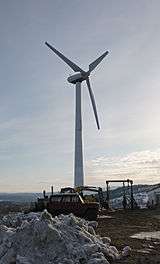
Russia has a long history of small-scale wind energy use but has never developed large-scale commercial wind energy production. Most of its current wind production is located in agricultural areas with low population densities where connection to the main energy grid is difficult. Russia is estimated to have a total potential of 80,000 TWh/yr for wind energy, 6,218 TWh/yr of which is economically feasible.[12] Most of this potential is found in the southern steppes and the seacoasts of Russia, although in many of these areas the population density is less than 1 person per square km. This low population density means that there is little existing electricity infrastructure currently in place, which hinders development of these resources.[6] In 2006, Russia had a total installed wind capacity of 15 MW.[34] Current Russian wind energy projects have a combined capacity of over 1,700 MW. The Russian Wind Energy Association predicts that if Russia achieves its goal of having 4.5% of its energy come from renewable sources by 2020, the country will have a total wind capacity of 7 GW.[35]
In 2010, plans for the construction of a wind power plant in Yeisk, on the Sea of Azov, were announced. It is expected to initially have a capacity of 50 MW, which will become 100 MW a year later.[34] German engineering company Siemens announced in July 2010, following a visit to Russia by Chancellor Angela Merkel, that it would build wind power plants in Russia.[1] By 2015, the company hopes to install 1,250 MW of capacity in Russia.[35]
Tidal energy
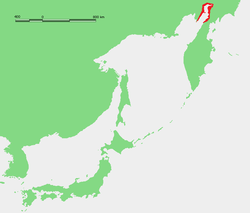
Russia has many tidal energy resources at its disposal, although they are currently underdeveloped as well. The Kola Bay and Sea of Okhotsk alone could produce 100 GW with tidal power stations, and the national energy potential from tidal energy can compete with current total energy production.[36] The currently active Kislaya Guba Tidal Power Station is the largest tidal power facility in Russia and has the fourth largest capacity (1.7 MW) among the world's tidal power plants.[37]
Plans for constructing an 800 MW tidal power plant in the Barents Sea were announced in 2008.[38] Possible long-term projects include the Penzhin Tidal Power Plant, which could become the largest power station in the world, with an installed capacity of up to 87 GW and an annual production of 200 TWh.[39]
Biofuel
Russia's biofuel industry is new, but it has been developing rapidly in recent years. Russia is one of the largest grain producers, has a well-developed ethyl alcohol industry and has increasing rapeseed (often used to create biodiesel) production rates.[40] The Russian government declared in 2008 that it would play an active role in developing the biofuel industry by building 30 new biofuel plants and providing tax breaks and subsidized interest rates to biofuel energy projects.[41] Although these plans were delayed, on 13 September 2010, Medvedev announced that construction would begin in early 2011.[42] Biobutanol, the biofuel produced by these plants, would be produced from timber by-products, such as woodchips and sawdust.[40][41][43]
.jpg)
Lada, a Russian car manufacturer, produced its first biofuel-powered automobile in November 2010. Deputy Transportation Minister Valery Okulov stated that Russian companies are currently developing helicopters that run on biofuel.[41] Russia hopes to export biofuel to the European Union;[44] the country's Biotechnology Corporation estimates that Russia is capable of exporting 40 million tons of biofuel annually.[45]
Biomass
Biomass is already used in some parts of Russia to provide a total of 1%, or 9 Twh/year, of Russia's total energy. However, due to Russia's vast forest and peat reserves,[nb 1] it has a total biomass technical potential of 431 Twh/year, of which 285 Twh/year is economically feasible.[46][47] Most of this potential is found in northwestern Russia, which has a developed pulp and paper industry that can provide wood-based waste to use as biomass energy.[48]
Use of peat for energy production was prominent during the Soviet Union, with the peak occurring in 1965 and declining from that point. In 1929, over 40% of the Soviet Union's electric energy came from peat, which dropped to 1% by 1980. Currently, Russia is responsible for 17% of the world's peat production, and 20% of the peat that it produces, 1.5 million tons, is used for energy purposes.[12][49] Shatura Power Station in Moscow Oblast and Kirov Power Station in Kirov Oblast are the two largest peat power stations in the world.[50][51]
See also
| Wikimedia Commons has media related to Renewable energy in Russia. |
- Energy policy of Russia
- Nuclear power in Russia
- Wind power in Russia
- Geothermal power in Russia
- Renewable energy by country
Notes
References
- 1 2 3 Trevor Sievert (23 July 2010). "Russia- Russian Wind Power". Industry News. Retrieved 25 February 2011.
- ↑ Raili Kajaste (23 October 2008). "NEFCO Renewable Energy Projects in Russia" (PDF). NEFCO. Retrieved 26 February 2011.
- ↑ "Russia- Electrity". U.S. Energy Information Administration. November 2010. Retrieved 23 January 2011.
- ↑ Anastasia Kostomarova, James Blake (25 August 2009). "Russian renewable energy prepares for a bigger slice of the power pie". Business RT. Retrieved 23 January 2011.
- 1 2 Mikhail Klementiev (27 May 2010). "Medvedev orders incentives for renewable energy use". RIA Novosti. Retrieved 23 January 2011.
- 1 2 3 Renewables: The Energy for the 21st Century. World Renewable Energy Congress VI. 1–7 July 2000. Retrieved 25 February 2011.
- 1 2 3 4 "Hydropower in Russia". RusHydro. 2008–2009. Retrieved 28 January 2011.
- ↑ "Soviet Union- Energy Planning Goals". country-data.com. May 1989. Retrieved 30 January 2011.
- ↑ Andrew Kramer (20 August 2009). "Decaying Soviet Infrastructure Shows Its Era". The New York Times. Retrieved 30 January 2011.
- 1 2 David Amstell (10 December 2009). "Russian Energy efficiency: Medvedev's new favourite topic?". PE Power & Energy. Retrieved 30 January 2011.
- ↑ "Russia – Grid Summary". Global Energy Network Institute. 2010. Retrieved 23 January 2011.
- 1 2 3 4 5 6 7 "2007 Survey of Energy Resources" (PDF). World Energy Council 2007. 2007. Retrieved 23 January 2011.
- ↑ "14.24. BASIC INDICATORS OF ORGANISATIONS BY KIND OF ECONOMIC ACTIVITIES – "PRODUCTION AND SUPPLY OF ELECTRICITY, GAS AND WATER"". Федеральная служба государственной статистики. 2010.
- ↑ Rachel Morarjee (18 November 2010). "Red to green: Russia begins energy saving". Business New Europe. Retrieved 29 January 2011.
- 1 2 "Russia". European Bank for Reconstruction and Development. 2010. Retrieved 23 January 2011.
- ↑ Indrea Overland, Heidi Kjaernet (2009). Russian Renewable Energy – The Potential for International Cooperation. Ashgate Publishing Ltd. Retrieved 25 February 2011.
- ↑ "Russia appoints Sechin ally to manage hydro giant". Reuters. 23 November 2009. Retrieved 30 January 2011.
- ↑ "Russia's EuroSibEnergo signs deal with China's hydro power corporation". RIA Novosti. 2 December 2010. Retrieved 26 February 2011.
- ↑ "West Siberian genco to build 8 hydro-electric plants in Altai". RIA Novosti. 15 December 2010. Retrieved 26 February 2011.
- 1 2 Joe Hasler (2 February 2010). "Investigating Russia's Biggest Dam Explosion: What Went Wrong". Popular Mechanics. Retrieved 6 December 2011.
- ↑ "Report Lays Out Blame for Power Plant Explosion". The Other Russia. 29 December 2009. Retrieved 6 December 2011.
- ↑ Valentina Svalova (September 2003). "Geothermal energy use in Russia" (PDF). International Geothermal Conference. Retrieved 23 January 2011.
- ↑ "Russia, Iceland to tap geothermal energy sources: minister". China Daily. 26 October 2010. Retrieved 25 February 2011.
- ↑ "Moscow ready to offer breaks to foreign investors on Kurils". RIA Novosti. 11 February 2011. Retrieved 6 March 2011.
- ↑ "PV Watts". NREL. Retrieved 16 April 2012.
- ↑ "The first solar power plant has been constructed in Russia". Newsland. 13 November 2010. Retrieved 15 March 2011.
- 1 2 "Sunless Russia seeks more solar energy". International Business Times. 8 October 2010. Retrieved 30 January 2011.
- ↑ "Russia to build first solar power plant". Power-GEN Worldwide. 3 November 2010. Retrieved 23 January 2011.
- ↑ Jason Bush (14 July 2009). "Nitol, Russia's Emerging Solar Power Star". Spiegel Online International. Retrieved 21 February 2011.
- ↑ "India, Russia exploring JV in solar photo-voltaic cells". Russia & India Report. 21 February 2011. Retrieved 6 March 2011.
- ↑ Results of the renewable energy capacity tenders in Russia
- ↑ Russia Approves 365 MW of Clean Energy Projects in Tender
- ↑ Angelina Davydova (2015-12-21). "Solar power surges – slowly – in regulation-heavy Russia". Thomson Reuters Foundation. Retrieved 2016-05-21.
- 1 2 "Russia to spend $200 million on largest wind-power plant". RIA Novosti. 30 July 2010. Retrieved 23 January 2011.
- 1 2 Honey Garcia (16 July 2011). "Siemens makes a bid for Russia's wind power through joint venture". Ecoseed. Retrieved 6 March 2011.
- ↑ "Russian power plants soon to utilize tidal energy". Russia InfoCentre. 24 June 2005. Retrieved 23 January 2011.
- ↑ A. M. Gorlov (2001). "Tidal Energy" (PDF). Northeastern University. Retrieved 23 January 2011.
- ↑ "Tidal power for northernmost Russia". Barnets Observer. 2 June 2008. Retrieved 23 January 2011.
- ↑ Usachev, I. N.; Shpolyanskiy, Y. B.; Istorik, B. L.; Kuznetsev, V. P.; Fateev, V. N.; Knyazev, V. A. (2008). Приливные электростанции (ПЭС) — источник энергии, запасаемый в водороде [Tidal power plants (TPP) — a source of energy, store-able in hydrogen] (PDF). 2nd International Forum "Hydrogen technologies for developing world" (in Russian). Moscow. Retrieved 24 December 2010.
- 1 2 "Russia Biofuels Activities". Asia-Pacific Economic Cooperation. 2008. Retrieved 28 January 2011.
- 1 2 3 "Russia's biofuel energy revolution". Modern Russia. 22 November 2010. Retrieved 28 January 2011.
- ↑ "First Biofuel Plant to be built in Russia". Russian Geographical Society. 19 October 2010. Retrieved 28 January 2011.
- ↑ "Russia's first biofuel plant". Rossiyskaya Gazeta. 6 October 2010. Retrieved 28 January 2011.
- ↑ "Russia wants to export biofuels and game to EU". RIA Novosti. 6 September 2010. Retrieved 28 January 2011.
- ↑ "Russian Biofuel Industry Set to Reign European Market". RNCOS Industry Research Solutions. 18 May 2009. Retrieved 30 January 2011.
- ↑ Elena Douraeva (2003). "Opportunities for Renewable Energy in Russia" (PDF). International Energy Agency. Retrieved 29 January 2011.
- ↑ Timo Karjalainen, Yuri Gerasimov (September 2008). "Energy Wood Potential in Northwest Russia" (PDF). Finnish Forest Research Institute. Retrieved 29 January 2011.
- ↑ Elena Merle-Beral. "Waking the Giant" (PDF). Our Planet. Retrieved 29 January 2011.
- ↑ "Peat: Useful Resource or Hazard?". Russian Geographical Society. 10 August 2010. Retrieved 29 January 2011.
- ↑ "Shatura Power Station". The Fourth Generation Company of the Wholesale Electricity Market. 2007. Retrieved 31 January 2011.
- ↑ "Russia's peat generation". The Milwaukee Journal. 20 March 1959. Retrieved 31 January 2011.


